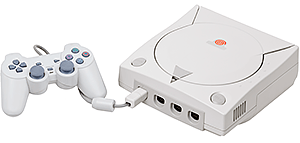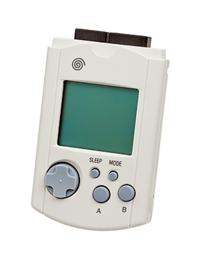Dreamsphere
 | |
| Developer | Gyldiv |
|---|---|
| Manufacturer | Gyldiv |
| Type | Home video game console |
| Generation | Sixth generation |
| Release date | 2000 |
| Lifespan | 2000–present |
| Discontinued | 2010 |
| Media | CD-ROM |
| Online services | DreamNet |
| Predecessor | Ion |
| Successor | Aura |
The Dreamsphere is a post-64-bit home video game console developed by Gyldiv.
It marked several important landmarks for Gylian home consoles: the leap from 2D to 3D computer graphics, the switch to CD-ROM as primary storage medium, and built-in support for the internet and online play.
Well-received on release and boasting several creative and innovative games in its library, the Dreamsphere was discontinued in 2010, but continues to be supported by Gyldiv and enjoys an enduring following.
History
Development of the Dreamsphere began in 1997. It came on the heels of the Ion and Orthogon, Gyldiv's first handheld console. Much of the project's foundation came from Gyldiv's work on the Ion CD and Satellaview — where those had been accessories, the new console was designed from the start to run on CD-ROMs and have online capabilities.
To control manufacturing costs, Gyldiv chose hardware in line with contemporary PCs, using "off-the-shelf" graphics processors. Due to advances in console technology at the time, it was decided to avoid referring to bit ratings; "post-64-bit" was adopted for simplicity.
The name "Dreamsphere" was chosen after a public competition, breaking the previous Hellene naming theme of the Exo, Ion, and even the Orthogon. One accessory was produced during development, the VMU, and it was decided to release it together with the console.
The Dreamsphere was released in 2000, thus cementing Gyldiv's "rather accidental" development cycle of one console per decade. It was critically and commercially successful, becoming one of Gylias' most popular consoles, and building on the Ion's following abroad.
Gyldiv discontinued the Dreamsphere upon release of the Aura in 2010, but continues to support it, including providing official emulators and game ports for other systems.
Technical specifications
The Dreamsphere is a post-64-bit console. It has a two-way CPU clocked at 200 MHz, and a 100 MHz graphics processing unit, which can render more than 3 million polygons per second and supports a variety of graphics effects. Its video display resolution is 640×480.
Its sound processor supports 64 PCM/ADPCM channels, and has support for MIDI and surround sound.
It includes a 56 kbit/s line modem, which users can remove and substitute for other dial-up or broadband internet connections. The console has an online service known as DreamNet, which runs through Proton Games.
Accessories
VMU
The Visual Memory Unit, abbreviated VMU, is the Dreamsphere's primary memory card. It features a monochrome LCD, multiplayer capability, second screen functionality, a real-time clock, file manager, built-in flash memory, and sound capability.
While mainly serving as a removable storage device, it was also used as an auxiliary display by many Dreamsphere games, providing minigames and bonus in-game features. It can also act as a standalone handheld game console.
Game library
The Dreamsphere featured an extensive and diverse library of games, garnering a reputation for "colourful graphics and remarkable creativity", according to GameCentral. Many of its games were fully 3D, taking advantage of the system's capacity, and it also included pioneering online console games.
Notable hit games included Space Channel 5, Skies of Arcadia, Jet Set Radio, and Um Jammer Lammy. Microworld provided a combination of both new RPGs such as Skies of Arcadia and The Legend of Heroes, and Dreamsphere remakes of the Lunar series and Tales of Phantasia. Companies like Dreamwave Games notably contributed a series of critically acclaimed licensed games.
Reception and legacy
The Dreamsphere garnered critical acclaim and commercial success upon release. It became one of Gylias' most popular gaming consoles, and expanded on the Ion's success abroad. Its innovations, such as high-quality 3D art and cinematics, online play, downloadable content, in-game voice chat, and second screen technology, exerted a significant influence on Gylian video gaming as a whole.
GameCentral writes that the enduring appeal and popularity of the console lies in its diverse library and its perception as a symbol of "fast fun and bright, attractive graphics", in opposition to other subsequent gaming trends that clashed with Gylian tastes. Delkoran developer Zoë Qvist described the Dreamsphere as "admirable in its commitment to accessibility and appeal to casual gamers".
In the context of the Tyranian console war, the Dreamsphere's main competitor was Qualia's Qube 360, as Megelanese developers had largely exited after the abandonment of a 128-bit console prototype.
Although the Dreamsphere was discontinued in 2010, it continues to be supported by Gyldiv to this day, and enjoys a dedicated following among retrogaming and homebrew communities due to its open platform status and compatibility with personal computers.
